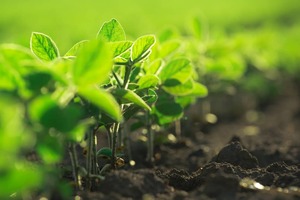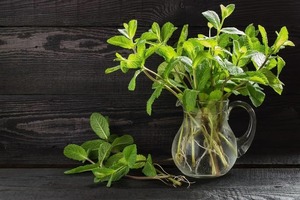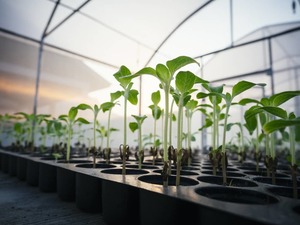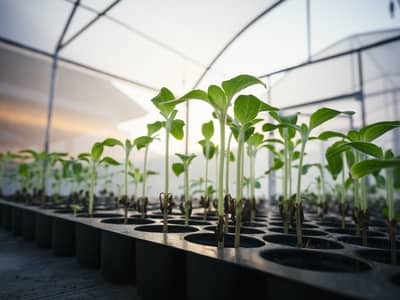If you’re building, expanding, or thinking about building a greenhouse, you may be wondering about the benefits of growing in soil versus growing in water. Plants need both water and nutrients to grow, and gardeners can choose whether they want to grow their plants in soil for nutrients and then water them, or if they want to plant directly in nutrient-enriched water.
Choosing whether to plant in soil or water depends on the space you have available and your personal preferences, but both are good options for greenhouse gardening! That being said, research has recently shown that hydroponic systems (planting in water) may be better for growth overall.

Why plants need water
We know that plants need light, nutrients, and water to thrive. But how does water help plants?
It acts as a kind of transportation system for nutrients from the roots out to the leaves, ensuring that all parts of the plant receive the nutrients they need to thrive.
Without water, the roots would be the only part of the plant benefiting from those nutrients.
It’s important to know that different plants need different amounts of water. Some plants will drink more than others, and it is good to remember that you can over-water your plants.
I was always worried my plants weren’t getting enough water–I didn’t realize that my plants could drown if I gave them too much.
The amount of water plants need also depends on the weather and time of year.
If it’s a particularly rainy time of year, you won’t have to do as much manual watering.
On the other end of the spectrum, if it’s hot and dry, you’ll notice that your plants are depending on more water than they typically would.
Just like humans, plants need water at all times, but the amount they need can vary.
Why plants need nutrients
Now we know that water allows the nutrients to reach all parts of the plants.
What are these nutrients, and why do plants need them?
Simply put, nutrients are plant food.
They give the plant energy to grow, just like food does for us.
Calcium, phosphorous, nitrogen, potassium, magnesium, and sulfur are the major nutrients that plants need in order to grow.
Basically, those nutrients allow plants to:
- photosynthesize efficiently (turning sunlight, water, & carbon dioxide into carbohydrates),
- create healthy roots,
- build a rigid support structure,
- produce flowers,
- set fruit, etc.
As you choose whether you’ll be gardening with soil or water, these nutrients will be essential to your success!
Traditionally, gardeners have used soil to provide these nutrients and then they have watered their plants.
However, planting in water and adding nutrients directly to the water is a great option that many gardeners find more effective than soil planting.
Growing plants in soil
Typically, gardeners choose to grow in soil if they have a large growing space and access to good, fertile soil.
If this sounds like your planting situation, soil growth can be a great option for you!
You will likely need to add nutrients to soil regardless, in order to make sure your plants will receive all of the nutrients they need.
You can add these through compost, manure, or a fertilizer you can buy at any hardware/plant store.
Soil also contains bacteria and earthworms, which help break down the elements of the soil into digestible nutrients for the plants.
This is a slight drawback of soil: the nutrients aren’t just readily available for the plants to consume.
However, as long as your soil is rich in bacteria and you can see those earthworms squiggling around, you’ll have nutrient-rich soil!
The main benefit of soil is that if you have space and access, soil planting is very inexpensive. It’s also great if you want to plant a significant amount of vegetables or other plants.
There are a couple of drawbacks to soil.
First of all, you have to maintain the pH and measure the nutrients to make sure that your plants are receiving the food that they need.
Soil loses its nutrient richness over time, so monitoring those levels is really important.
It can also be easy to overwater with soil planting because the soil absorbs the water really quickly.
Because of that, it’s hard to see exactly how much water you’re giving your plants.

Growing plants in water: hydroponics
Another growing option for plants that’s becoming more popular is hydroponics.
Basically all that means is growing plants in water but without soil.
Some gardeners who use hydroponics also put sand, gravel, or larger rocks in their pots or planting trays, but water is the main ingredient here.
If you want to dive deeper into hydroponics, check out our complete article on getting started with hydroponics.
It’s important to note that plants cannot grow in just water. Without those nutrients we talked about earlier, your plants won’t survive very long.
However, you can easily add nutrients to the water, and then your plants will have everything they need to thrive.
If you’ve ever bought a bouquet of flowers and added the “plant food” to the vase of water, you already have hydroponic experience!
The advantages of hydroponics
Growing plants in water allows you to easily monitor nutrient levels and add more if need be.
It’s also really easy to see whether or not your plants are getting enough water!
This will help you make sure you aren’t over- or under-watering your plants.
Also, scientists have recently found evidence that plants may grow more quickly and larger than plants grown in soil (more on that below), so this would be a serious benefit to growing in water.
Curious what you can grow with hydroponics? Check out our complete article on what you can grow using hydroponics.
It might seem ironic that plants can drown if they’re over-watered, but can actually grow more quickly and grow larger in hydroponic systems.
What’s up with that?
Well, if you simply over-water your plants, they drown–they have no way of getting oxygen to the roots.
With hydroponic systems, you monitor the amount of oxygen in the water–that way, the roots get enough oxygen, and therefore, the plant won’t drown.
The downsides of hydroponics
The main drawback of growing plants hydroponically is the initial cost.
If you set up a hydroponic system, you’ll likely be purchasing pumps, reservoirs, trays, and possibly other materials such as timers and grow lights.
These materials are more expensive than soil, especially if you have access to free soil already.
That being said, many gardeners who use hydroponic systems say that the initial investment is worth it and they end up saving money over time.
Plant growth in soil versus water
If you’re intrigued by the hydroponic system, you’ll be excited to know that scientists and master gardeners are studying its effectiveness. Especially as compared to growing plants in soil.
Several studies have shown that plants can grow larger and more quickly in hydroponic systems than they do in soil.
This may be especially beneficial to you if you’re looking to produce a lot of vegetables or fruit in order to preserve, give away, or sell them.
Also, researchers have found that, in general, plants are more likely to survive in hydroponic systems than in soil.
This finding still needs to be tested more widely with many different kinds of produce.
But even so, it’s encouraging and really interesting!
Flavor of produce in soil versus water
One of the reasons the farm-to-table movement is so popular right now is because you can taste the freshness of the vegetables and fruit when you get them directly from a farm.
How much of this fresh taste is a result of the soil the plants grow in?
According to several growers, plants grown hydroponically produce vegetables and fruits filled with flavor.
Unless you were looking for it, it would be difficult to tell whether the fruits and vegetables on your plate grew in soil or water.
As of now, growers and researchers haven’t found a difference in flavors between the two growing options.
Comparing soil growth and hydroponic growth
| Soil | Hydroponic system | |
|---|---|---|
| Cost | Very inexpensive | Expensive initially but may save money in the long run |
| Maintenance required | Monitoring pH, watering, making sure to not over- or under-water | Initial maintenance – building hydroponic system. Very little maintenance needed after system installation is complete |
| Speed of plant growth | Speed is typically sufficient for most growers but water growth may be faster | Plants may grow larger and faster in water than in soil |
| Flavor quality | On par with water-grown. Fresh! | On par with soil-grown. Flavorful and delicious! |
Choosing soil or water growth for your greenhouse
In the end, choosing whether to plant your produce in water or soil is up to you. Now that you know the benefits and drawbacks of each system, it’s really about personal preference and your circumstances.
If you have some extra cash, investing in a hydroponics system may be a good idea for you.
If you have access to a lot of soil and want to grow plants in a large space, soil may be better.
The decision is in your hands!

Related Questions
Can plants grow without soil?
Yes, as long as you’re making sure plants get their nutrients some other way, you can grow without soil.
Being a successful gardener is really about making your space and your resources work for you, so if gardening without soil seems best, you can definitely make that switch.
Do plants grow better inside or outside?
This depends on the type of plant and the time of year. Since plants need different amounts of light and thrive in different temperatures, they will sometimes thrive best outside and sometimes inside.
Essentially, you just need to make sure they’re getting the right amount of light, nutrients, and water.
How do I build a hydroponic system?
To build a hydroponic system, you’ll need a nutrient tank, pH strips to test the nutrient levels, the nutrients, pipes for the water to travel through, and a tray where your plants will live (some people use growing trays, others use PVC pipes with holes cut into them for the plants).


